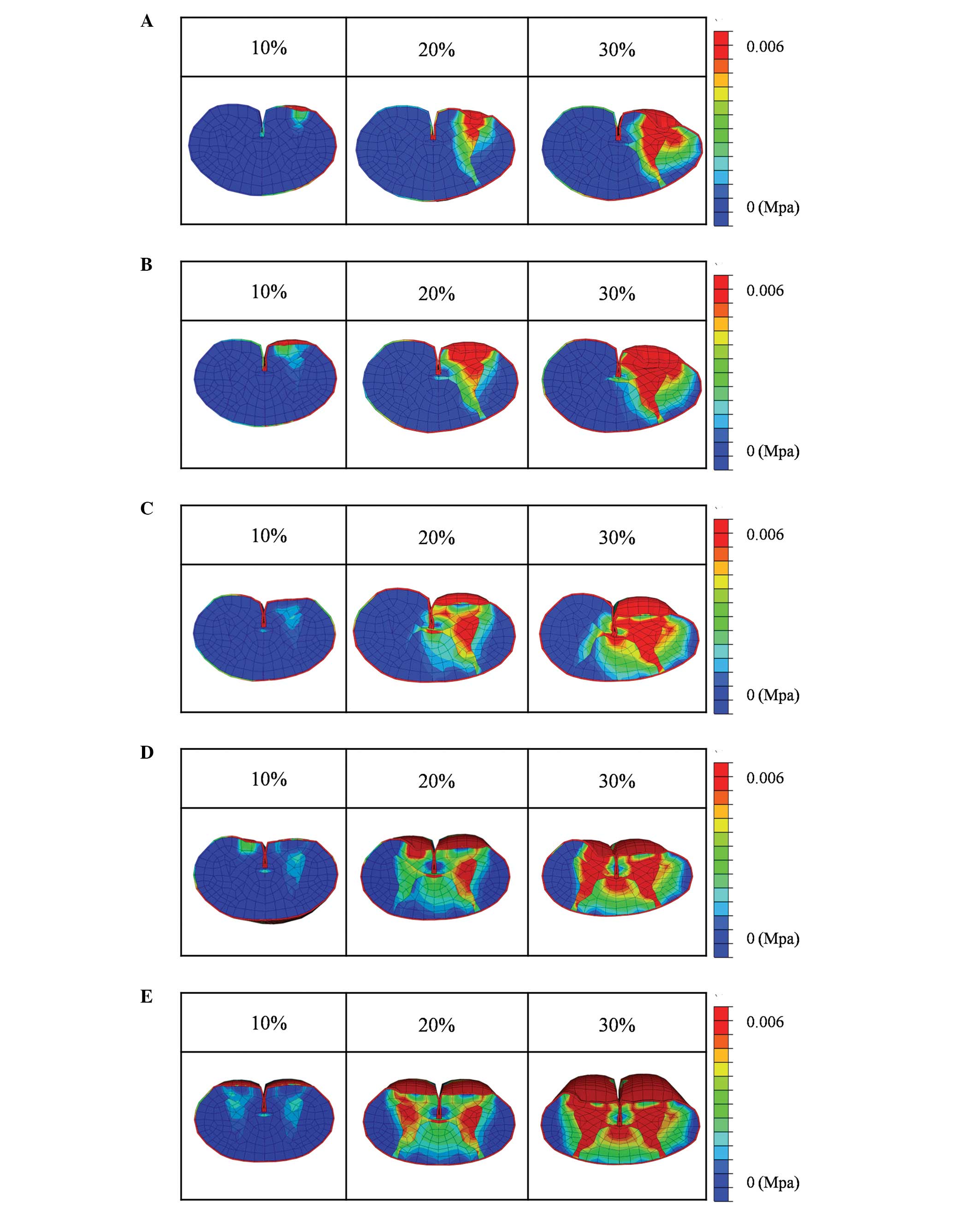|
1.
|
Kraus JA, Stuper BK and Berlit P: Multiple
sclerosis presenting with Brown-Séquard syndrome. J Neurol Sci.
156:112–113. 1998.
|
|
2.
|
Fisher RG: Protrusions of thoracic disc.
The factor of herniation through the dura matter. J Neurosurg.
22:591–593. 1965. View Article : Google Scholar : PubMed/NCBI
|
|
3.
|
Love JG and Schorn VG: Thoracic-disc
protrusions. JAMA. 191:627–631. 1965. View Article : Google Scholar
|
|
4.
|
Koehler PJ and Endtz LJ: The Brown-Séquard
syndrome. True or false? Arch Neurol. 43:921–924. 1986.
|
|
5.
|
Persson C, Summers J and Hall RM: The
importance of fluid-structure interaction in spinal trauma models.
J Neurotrauma. 28:113–125. 2011. View Article : Google Scholar
|
|
6.
|
Ichihara K, Taguchi T, Shimada Y,
Sakuramoto I, Kawano S and Kawai S: Gray matter of the bovine
cervical spinal cord is mechanically more rigid and fragile than
the white matter. J Neurotrauma. 18:361–367. 2001. View Article : Google Scholar : PubMed/NCBI
|
|
7.
|
Ichihara K, Taguchi T, Sakuramoto I,
Kawano S and Kawai S: Mechanism of the spinal cord injury and the
cervical spondylotic myelopathy: new approach based on the
mechanical features of the spinal cord white and gray matter. J
Neurosurg. 99(Suppl 3): 278–285. 2003.PubMed/NCBI
|
|
8.
|
Tunturi AR: Elasticity of the spinal cord,
pia, and denticulate ligament in the dog. J Neurosurg. 48:975–979.
1978. View Article : Google Scholar : PubMed/NCBI
|
|
9.
|
Brown Sequard CE: De la transmission des
impressions sensitives par la moelle epiniere. CR Soc Biol.
1:192–194. 1849.
|
|
10.
|
Kobayashi N, Asamoto S, Doi H and Sugiyama
H: Brown-Séquard syndrome produced by cervical disc herniation:
report of two cases and review of the literature. Spine J.
23:530–533. 2003.
|
|
11.
|
Kohno M, Takahashi H, Yamakawa K, Ide K
and Segawa H: Postoperative prognosis of Brown-Séquard-type
myelopathy in patients with cervical lesions. Surg Neurol.
51:241–246. 1999.
|
|
12.
|
Mastronardi and Ruggeri A: Cervical disc
herniation producing Brown-Séquard syndrome: case report. Spine
(Phila Pa 1976). 29:E28–E31. 2004.PubMed/NCBI
|
|
13.
|
Jomin M, Lesoin F, Lozes G, et al:
Herniated cervical discs. Analysis of a series of 230 cases. Acta
Neurochir (Wien). 79:107–113. 1986. View Article : Google Scholar : PubMed/NCBI
|
|
14.
|
Choi KB, Lee CD, Chung DJ and Lee SH:
Cervical disc herniation as a cause of Brown-Séquard syndrome. J
Korean Neurosurg Soc. 46:505–510. 2009.
|
|
15.
|
Arce CA and Dohrmann GJ: Herniated
thoracic disks. Neurol Clin. 3:383–392. 1985.
|
|
16.
|
Massicotte EM, Montanera WR, Ross Fleming
JF, Tucker WS, Willinsky R, TerBrugge K and Fehlings MG: Idiopathic
spinal cord herniation: report of eight cases and review of the
literature. Spine (Phila Pa 1976). 27:E233–E241. 2002. View Article : Google Scholar : PubMed/NCBI
|
|
17.
|
Miyaguchi M, Nakamura H, Shakudo M, Inoue
Y and Yamano Y: Idiopathic spinal cord herniation associated with
intervertebral disc extrusion: a case report and review of the
literature. Spine (Phila Pa 1976). 26:1090–1094. 2001. View Article : Google Scholar : PubMed/NCBI
|
|
18.
|
Wada E, Yonebu K and Kang J: Idiopathic
spinal cord herniation: report of three cases and review of the
literature. Spine (Phila Pa 1976). 25:1984–1988. 2000. View Article : Google Scholar
|
|
19.
|
White BD and Tsegaye M: Idiopathic
anterior spinal cord hernia: under-recognized cause of thoracic
myelopathy. Br J Neurosurg. 18:246–249. 2004. View Article : Google Scholar : PubMed/NCBI
|
|
20.
|
Sasari M, Ozer AF, Vural M and Sarioglu
AC: Idiopathic spinal cord herniation: case report and review of
the literature. J Spinal Cord Med. 32:86–94. 2009.PubMed/NCBI
|
|
21.
|
Kato Y, Kataoka H, Ichihara K, et al:
Biomechanical study of cervical flexion myelopathy using a
three-dimensional finite element method. J Neurosurg Spine.
8:436–441. 2008. View Article : Google Scholar : PubMed/NCBI
|
|
22.
|
Kato Y, Kanchiku T, Imajo Y, et al:
Flexion model simulating spinal cord injury without radiographic
abnormality in patients with ossification of the longitudinal
ligament: the influence of flexion speed on the cervical spine. J
Spinal Cord Med. 32:555–559. 2009.
|
|
23.
|
Kato Y, Kanchiku T, Imajo Y, et al:
Biomechanical study of the effect of the degree of static
compression of the spinal cord in ossification of the posterior
longitudinal ligament. J Neurosurg Spine. 12:301–305. 2010.
View Article : Google Scholar : PubMed/NCBI
|
|
24.
|
Li XF and Dai LY: Three-dimensional finite
element model of the cervical spinal cord: preliminary results of
injury mechanism analysis. Spine (Phila Pa 1976). 34:1140–1147.
2009. View Article : Google Scholar : PubMed/NCBI
|
|
25.
|
Li XF and Dai LY: Acute central cord
syndrome: injury mechanisms and stress features. Spine (Phila Pa
1976). 35:E955–E964. 2010. View Article : Google Scholar : PubMed/NCBI
|
|
26.
|
Nishida N, Kato Y, Imajo Y, Kawano S and
Taguchi T: Biomechanical study of the spinal cord in thoracic
ossification of the posterior longitudinal ligament. J Spinal Cord
Med. 34:518–522. 2011. View Article : Google Scholar : PubMed/NCBI
|
|
27.
|
Nishida N, Kato Y, Imajo Y, Kawano S and
Taguchi T: Biomechanical analysis of cervical spondylotic
myelopathy: the influence of dynamic factors and morphometry of the
spinal cord. J Spinal Cord Med. 35:256–261. 2012. View Article : Google Scholar : PubMed/NCBI
|
|
28.
|
Henderson FC, Geddes JF, Vaccaro AR,
Woodard E, Berry KJ and Benzel EC: Stretch-associated injury in
cervical spondylotic myelopathy: new concept and review.
Neurosurgery. 56:1101–1113. 2005.PubMed/NCBI
|













